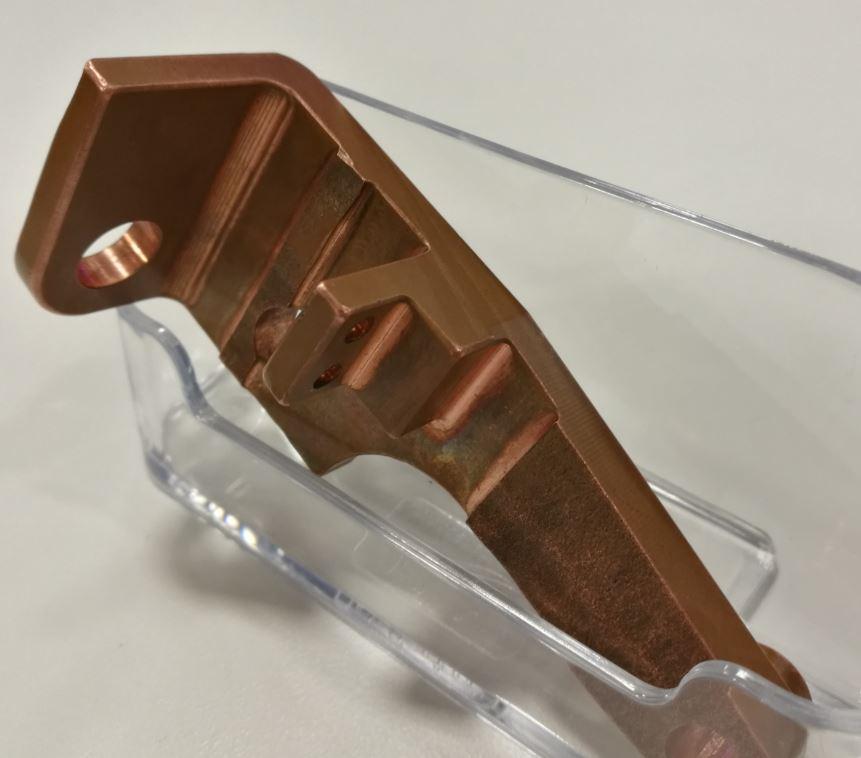Senior Editor
- FMA
- The Fabricator
- FABTECH
- Canadian Metalworking
Our Publications
Categories
- Additive Manufacturing
- Aluminum Welding
- Arc Welding
- Assembly and Joining
- Automation and Robotics
- Bending and Forming
- Consumables
- Cutting and Weld Prep
- Electric Vehicles
- En Español
- Finishing
- Hydroforming
- Laser Cutting
- Laser Welding
- Machining
- Manufacturing Software
- Materials Handling
- Metals/Materials
- Oxyfuel Cutting
- Plasma Cutting
- Power Tools
- Punching and Other Holemaking
- Roll Forming
- Safety
- Sawing
- Shearing
- Shop Management
- Testing and Measuring
- Tube and Pipe Fabrication
- Tube and Pipe Production
- Waterjet Cutting
Industry Directory
Webcasts
Podcasts
FAB 40
Advertise
Subscribe
Account Login
Search
Cold spray meets metal additive manufacturing
- By Tim Heston
- May 29, 2018
- Article
- Additive Manufacturing

On display at the RAPID+TCT show, this copper part was printed with cold-spray technology from Spee3D.
At the RAPID+TCT show in April, Todd Grimm, president of T.A. Grimm & Associates Inc., an Edgewood, Ky.-based marketing and consulting agency, showed a slide familiar to anyone in additive manufacturing. The slide illustrated the seven families of additive manufacturing technologies, according to ISO and ASTM standards. It’s technical and seemingly all-encompassing, covering everything from vat photopolymerization and binder jetting to powder bed fusion, sheet lamination, and directed energy deposition.
When Byron Kennedy saw that list, though, he couldn’t see where his company’s technology would fit into those categories. The CEO of Australia-based Spee3D, Kennedy’s company has developed a technology that basically adapts metal cold-spray technology to the additive world. To control costs, the cold spray technology sprays not with argon or nitrogen, but with air (which, of course, is mostly nitrogen) and generic, “potato-shaped” metal powders. According to the company, the technology can print a metal part in minutes.
“We’re talking production here,” Kennedy said. “We’re talking thousands of parts. Then, once you get above roughly 10,000 parts, that’s when die casting because cheaper.”
So how does the technology work, exactly? “We’re firing metal powders onto the surface at about 1,000 meters per second,” Kennedy explained, creating a metallurgical bond created through velocity. “When the particle hits the surface, it breaks the oxides on the particle and breaks the oxides on the surface. You get pure metal on metal contact. When that particle compresses, it cold-welds just along the surface. And the chemical composition of the part doesn’t change. If you spray 6061 aluminum, you get 6061. And you have no heat, so you have no thermal stresses.
“The key to the technology is the software,” Kennedy continued. “The software essentially gives the cold spray system the ability to build a precise shape, layer by layer. “It creates all the robotic code automatically to be able to build that part.”So now, along with those seven basic AM technologies, one could add this new type of cold spray on to the list.
It’s no secret that the standards-writing community has been struggling to keep up with all the technological developments in AM. This includes not only identifying the processes but also standards for inspection, which is driving a whole host of technologies in the scanning and software world, including finite element analysis.
From industry’s perspective, though, this isn’t necessarily a bad thing. In the world of AM, differentiation is everywhere. New methods drive new engineering and manufacturing practices. This year may look entirely different from the next. Every year, manufacturers have new ways to fabricate, be it for fixtures, jigs, or production parts. And of course, for investors and manufacturers in general, including metal fabricators, that’s just what makes additive manufacturing so attractive.
About the Author

Tim Heston
2135 Point Blvd
Elgin, IL 60123
815-381-1314
Tim Heston, The Fabricator's senior editor, has covered the metal fabrication industry since 1998, starting his career at the American Welding Society's Welding Journal. Since then he has covered the full range of metal fabrication processes, from stamping, bending, and cutting to grinding and polishing. He joined The Fabricator's staff in October 2007.
About the Publication
- Podcasting
- Podcast:
- The Fabricator Podcast
- Published:
- 04/30/2024
- Running Time:
- 53:00
Seth Feldman of Iowa-based Wertzbaugher Services joins The Fabricator Podcast to offer his take as a Gen Zer...
- Trending Articles
- Industry Events
Pipe and Tube Conference
- May 21 - 22, 2024
- Omaha, NE
World-Class Roll Forming Workshop
- June 5 - 6, 2024
- Louisville, KY
Advanced Laser Application Workshop
- June 25 - 27, 2024
- Novi, MI
Precision Press Brake Certificate Course
- July 31 - August 1, 2024
- Elgin,


























